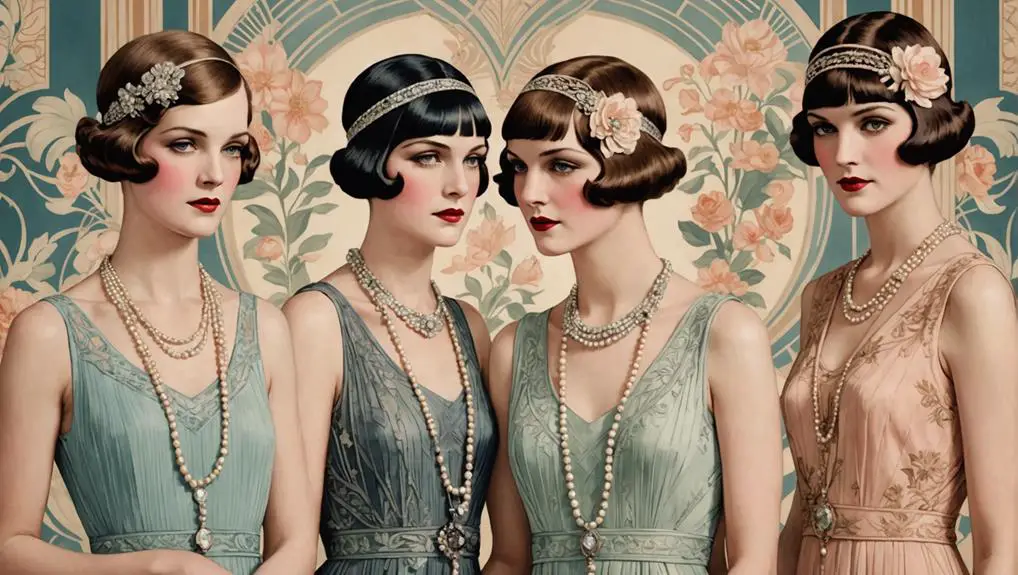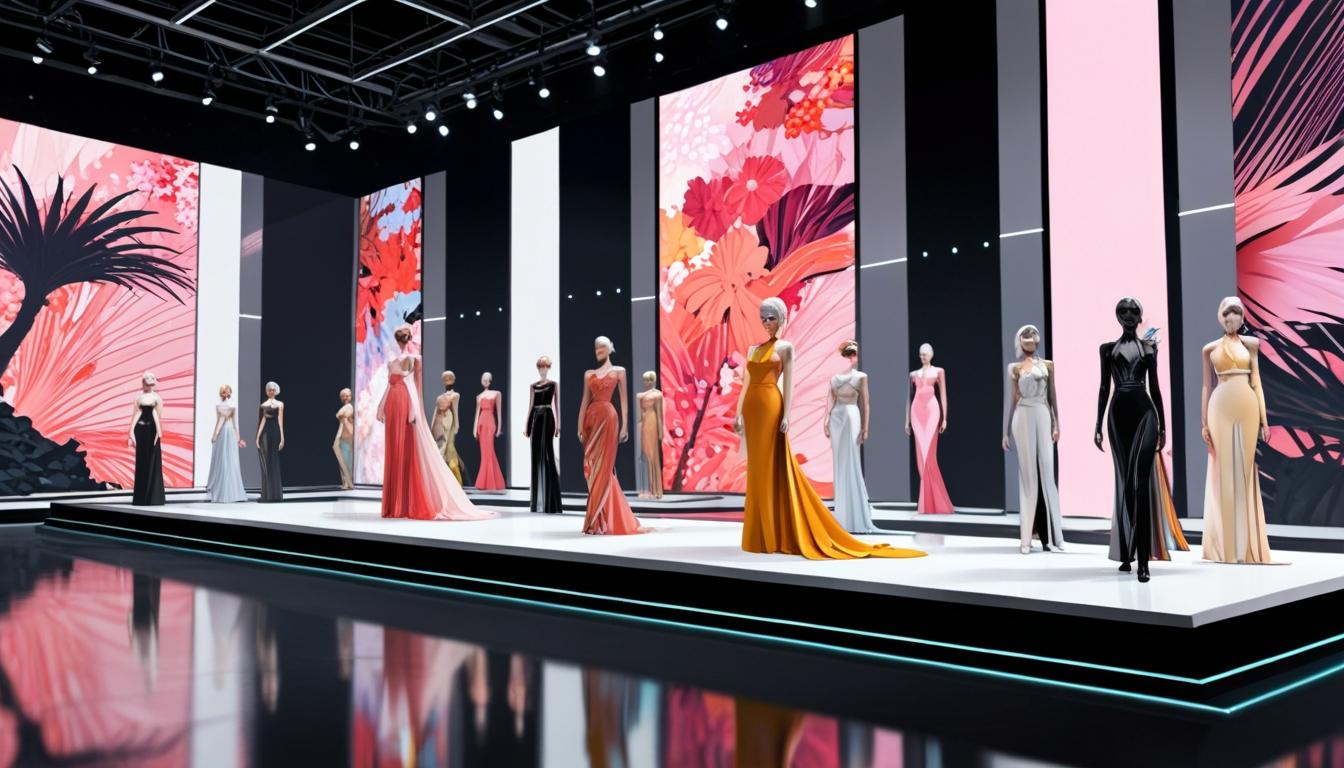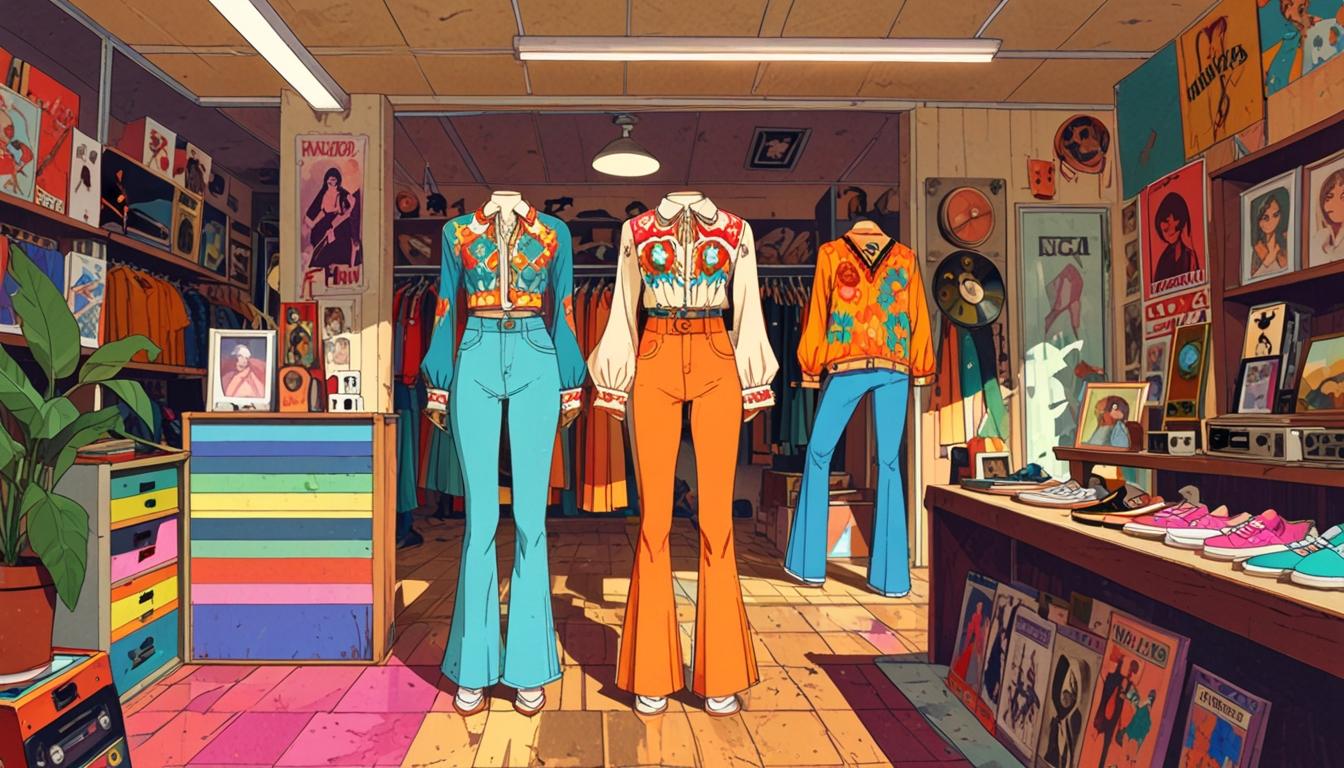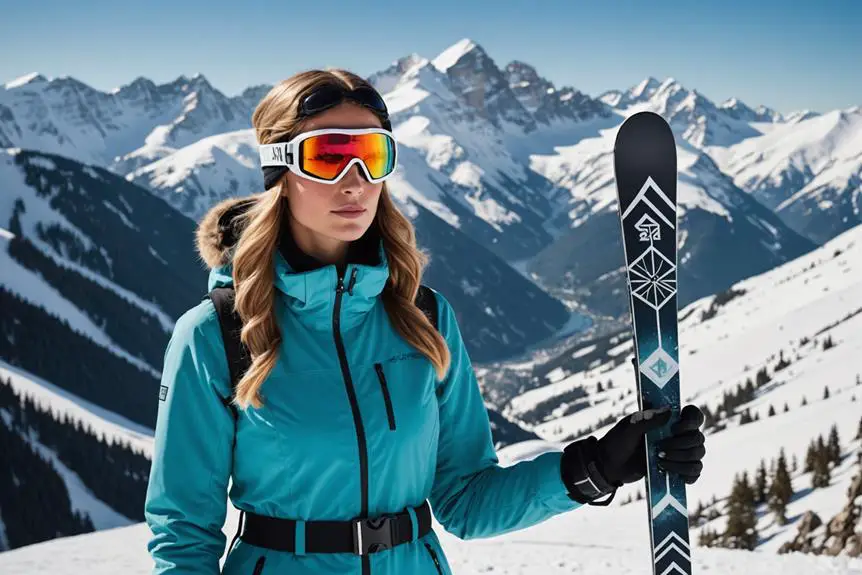In the 1920s, women's lace collars redefined style by blending sophistication with modern simplicity. You'd notice intricate floral patterns and scalloped edges adorning cotton, silk, and tulle, enhancing otherwise plain outfits. Designers like Coco Chanel and Paul Poiret popularized these collars, symbolizing femininity during a transformative era. Their versatility allowed for mixing and matching, showcasing individuality in fashion. Prices ranged from $12 to $25, making them accessible yet elegant. As you explore deeper, you'll uncover the craftsmanship and cultural significance behind these stunning accessories that encapsulated the spirit of the Roaring Twenties.
Historical Context of Lace Collars
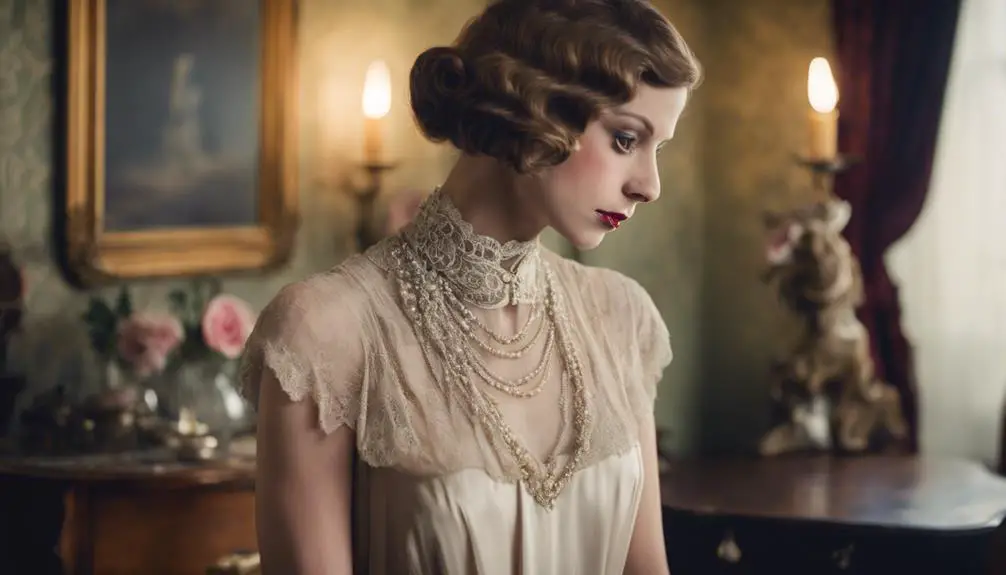
How did lace collars become a defining fashion accessory in the 1920s? This era marked a significant departure from the ornate Victorian styles of the previous century, embracing a fresh sense of femininity and elegance. Lace collars emerged as popular accents, often featuring delicate floral patterns and scalloped edges that added a touch of sophistication to simpler silhouettes. The shift towards streamlined designs meant that these collars, often crafted from cotton through techniques like crochet, became vital elements of women's wardrobes. Vintage clothing characteristics played an important role in the appeal of lace collars, as they reflected both the craftsmanship of the era and the emerging trends in fashion.
These handmade pieces not only reflected individual craftsmanship but also highlighted the growing trend toward personalization in fashion. Their versatility allowed them to complement various garments—from day dresses to evening wear—making them a practical choice for women seeking both style and function. In a time when vintage aesthetics began to gain appreciation, lace collars stood out as antique treasures that evoked nostalgia while being entirely contemporary.
With prices ranging from $12 to $25, these lace collars became accessible, symbolizing a blend of affordability and elegance. Consequently, they solidified their place as a defining fashion accessory in the 1920s, capturing the spirit of an era marked by change and liberation in women's fashion.
Popular Materials Used in Lace
The popularity of lace collars in the 1920s can be attributed to the diverse materials used in their creation, each contributing to the accessory's charm and functionality. Cotton emerged as the most favored fabric, valued for its durability and ease of care, making it a practical choice for everyday wear. Alongside cotton, silk and rayon offered luxurious alternatives, enhancing the elegance of these vintage pieces.
Intricate embroidery adorned many lace collars, with floral motifs and scalloped edges reflecting the era's artistic sensibilities. The craftsmanship involved often included unique bobbin lace techniques, showcasing the skill of artisans. Irish crochet lace also gained traction, celebrated for its elaborate hand-crafted patterns that added depth and texture.
Moreover, blending fabrics became a design hallmark, with cotton lace paired with satin or voile, creating striking visual contrasts. Such combinations not only elevated the aesthetic appeal but also guaranteed the collars remained versatile accessories. The hand-made nature of these vintage lace collars contributed to their collector interest, as each piece told a story of artistry and attention to detail. This blend of materials defined the lace collar trend, making it a lasting symbol of 1920s fashion.
Different Styles of Lace Collars
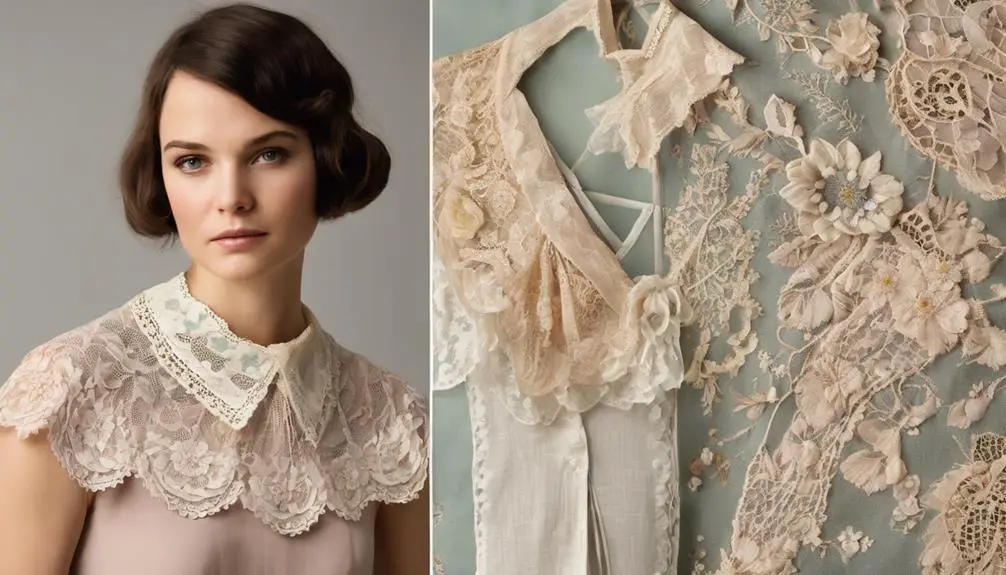
Lace collars in the 1920s showcased a remarkable variety of styles that not only reflected the fashion of the time but also highlighted the artistry involved in their creation. You'd find lace collar styles ranging from intricate bobbin lace to delicate embroidered tulle and charming crochet designs. Each type brought a unique flair, enhancing the elegance of dresses and adding a touch of vintage charm.
- Bobbin Lace: Known for its intricate patterns and delicate craftsmanship, perfect for adding sophistication.
- Embroidered Tulle: Featuring scalloped edges and floral motifs, this style captivated with its airy appearance.
- Detachable Collars: These versatile pieces allowed you to mix and match, adapting to different outfits easily.
With popular designs often made from cotton and rayon, these collars complemented 1920s fashion beautifully. The average price range of $12.00 to $25.00 USD made them accessible embellishments, offering women various options to express their style. Whether you wanted to dress up a simple dress or enhance an already stunning outfit, lace collars stood as a demonstration of the creativity and elegance prevalent in the roaring twenties.
Notable Designers of the Era
In the vibrant world of 1920s fashion, notable designers played a pivotal role in popularizing lace collars, transforming them into essential components of women's wardrobes. Coco Chanel emerged as a leading figure, integrating lace collars into her innovative collections, which redefined modern women's fashion. She emphasized simplicity and elegance, making lace a staple accessory that complemented the flapper movement's relaxed yet chic styles.
Paul Poiret also made significant contributions, introducing more relaxed silhouettes and incorporating lace collars to enhance femininity in his designs. His approach celebrated the body's natural form, allowing lace collars to add a delicate touch without overwhelming the overall silhouette.
The era's designers often showcased intricate embroidery and unique materials, experimenting with textures that made lace collars stand out. Madeleine Vionnet, known for her revolutionary draping techniques, emphasized the delicate nature of lace collars, highlighting their intricate detailing.
Together, these designers not only elevated lace collars but also reflected a broader shift in women's fashion during the 1920s, merging elegance with the casual flair that characterized the decade and resonated with the liberated spirit of the time.
Cultural Significance of Lace Collars
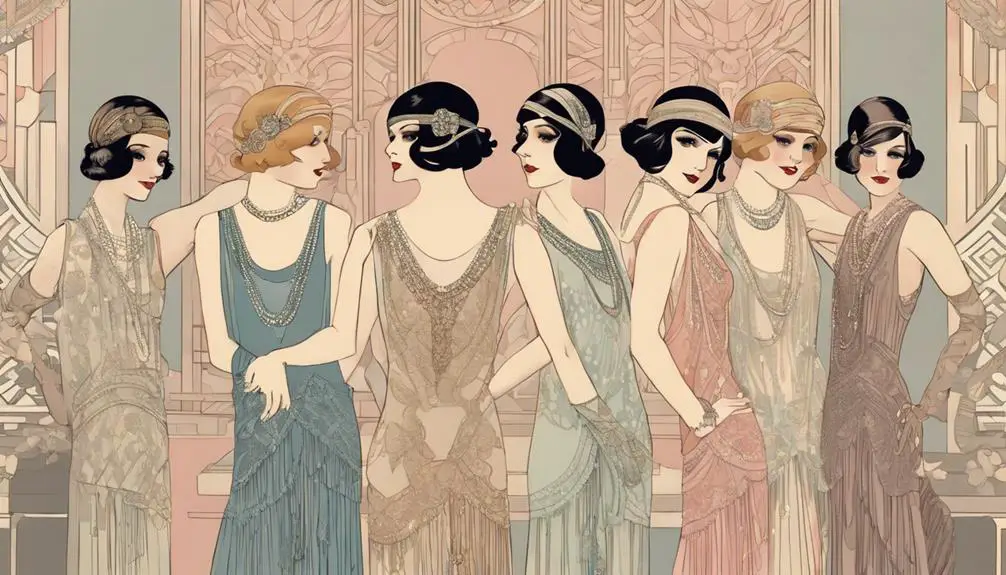
Elegance and self-expression defined the cultural significance of lace collars in the 1920s, as they became symbols of femininity and sophistication in women's fashion. These fashionable accessories not only enhanced outfits but also reflected the era's cultural shift towards liberated female identities.
- Intricate lace designs with floral patterns and scalloped edges showcased the craftsmanship of handmade pieces.
- The versatility of lace collars transformed basic garments into stylish ensembles, allowing women to express their individuality.
- As a blend of traditional femininity and modernity, lace collars marked a significant evolution in fashion during the Roaring Twenties.
The artisanal quality of these collars elevated their status, making them more than mere embellishments; they were statements of luxury and personal style. By incorporating lace collars into their wardrobes, women embraced the sophistication associated with the Art Deco aesthetic while asserting their individuality. This trend signified a departure from conventional attire, encouraging self-expression through fashion. Ultimately, lace collars in the 1920s exemplified the dynamic interplay between tradition and modernity, encapsulating the spirit of an era defined by change and empowerment.
Fashion Trends Influencing Collars
During the 1920s, various fashion trends substantially influenced the design and popularity of collars, reflecting the era's bold aesthetic choices. Lace collars became a hallmark of 1920s fashion, showcasing intricate designs that emphasized feminine charm. Styles featuring scalloped edges and floral designs flourished, often crafted from luxurious materials like cotton and silk, enhancing the overall elegance of women's garments. The significance of vintage tag identification also grew during this time, as identifying the origins of these embellishments became essential for collectors. The rise of the flapper style brought about unique collar embellishments, such as embroidery and beading, which added visual interest and sophistication to dresses and blouses. These embellishments not only elevated the garment but also expressed individuality and personal style. Many women favored custom or handmade pieces, showcasing their tastes and social status through these distinctive lace collars.
As the decade progressed, vintage lace collars grew in popularity, becoming highly sought after by collectors. Their rarity and craftsmanship reflected the intricate designs prevalent during this vibrant era, with prices ranging from $12 to $68 depending on the design and condition. The interplay of these fashion trends with lace collars not only defined the 1920s but also solidified their lasting impact on future fashion movements.
Accessories Complementing Lace Collars
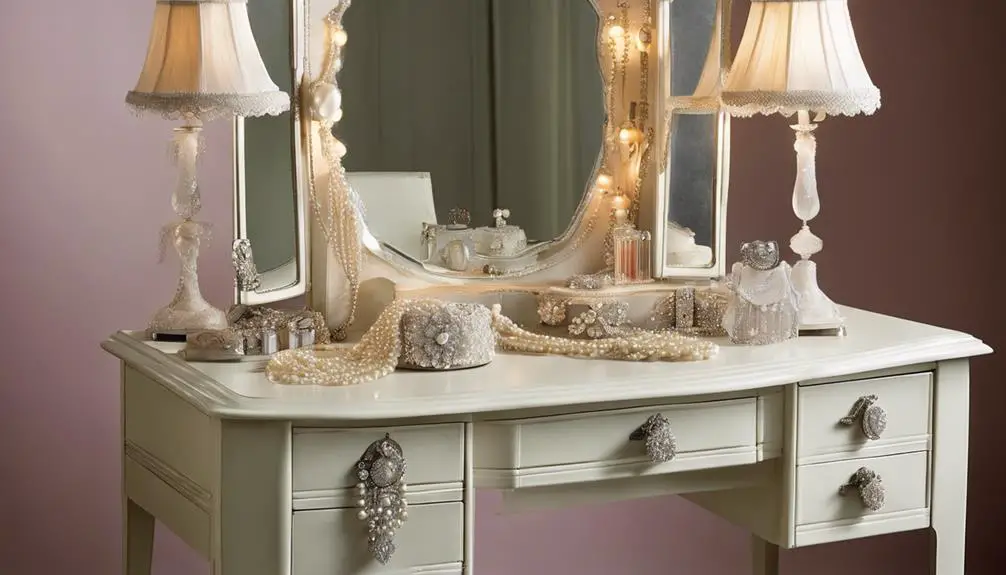
Lace collars of the 1920s found their perfect companions in a variety of accessories that enhanced their charm and sophistication. By thoughtfully selecting vintage accessories, you could elevate your ensemble, showcasing the intricate design of your lace collar while maintaining a polished look.
- Brooches: Adding a touch of elegance, these decorative pins personalized your outfit and drew the eye to your neckline.
- Detachable lace cuffs: Worn alongside lace collars, these cuffs created a coordinated and fashionable look, emphasizing the delicate details of both accessories.
- Silk ribbons and bows: These versatile additions allowed for customization, transforming the lace collar's appearance to suit various occasions.
Alongside these, delicate gloves became a staple, contributing to an overall refined aesthetic. Statement earrings or necklaces often accompanied the lace collars as well, further highlighting the collar's intricate design and framing your face beautifully. In the 1920s fashion landscape, these accessories not only complemented lace collars but also created an aura of sophistication, making you feel confident and stylish while embracing the elegance of the era.
Care and Maintenance of Lace
Caring for your exquisite lace collars requires attention to detail and a gentle touch to preserve their beauty. To maintain these delicate pieces, start by washing them gently by hand in cold water with a mild detergent. Avoid damaging the fibers by never wringing out your lace collars. Instead, lay them flat on a clean towel to absorb excess moisture, ensuring they retain their shape.
When it comes to storing your hand crochet lace collars, choose a cool, dry place. Wrapping them in acid-free tissue paper will protect against yellowing and light exposure. Ironing should be done on a low heat setting while the collars are slightly damp, or use a pressing cloth to shield the intricate designs from direct heat.
Here's a quick reference table for your lace care routine:
| Task | Instructions |
|---|---|
| Wash | Hand wash in cold water with mild detergent |
| Dry | Lay flat on a towel, don't wring |
| Store | Wrap in acid-free tissue paper |
| Iron | Use low heat, slightly damp, with pressing cloth |
Regularly inspect your lace collars for wear or damage to help prolong their life and maintain their beauty.
Collecting Vintage Lace Collars
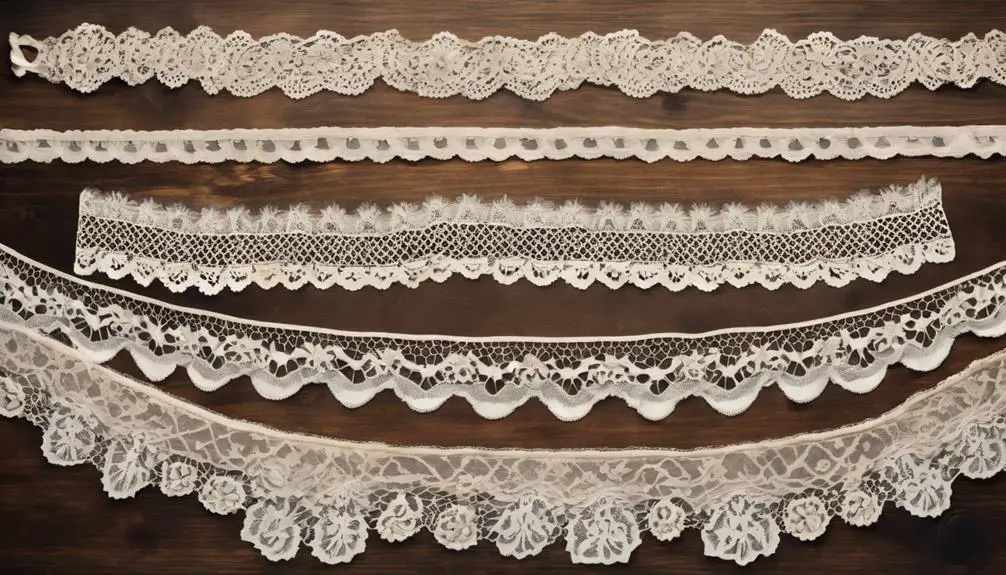
As you appreciate the beauty of lace collars, you might find yourself drawn to collecting vintage pieces from the 1920s. These collars feature unique designs that embody the fashion trends of the era, showcasing scalloped edges and intricate floral patterns that bring a touch of elegance to any outfit. Popular among collectors, 1920s lace collars often come in materials like cotton, silk, and tulle, enhancing their delicate appearance and desirability.
- Embroidered details that tell a story of craftsmanship.
- Cotton silk tulle that offers a soft, ethereal quality.
- Negotiable prices that make it easier to find the perfect addition to your collection.
When searching for vintage lace collars, items with historical significance—like those showcasing handcrafted elements—tend to attract more interest. These collars not only serve as beautiful accessories but also as pieces of history. Prices typically range from $12.00 to $35.00 USD, with well-preserved or rare items fetching higher values. With many online listings offering "or Best Offer" options, you can negotiate prices, making it easier to expand your collection while staying within budget. Happy hunting!
Modern Interpretations of Lace Collars
In recent years, fashion has embraced a resurgence of lace collars, seamlessly blending vintage charm with contemporary flair. Modern interpretations often draw inspiration from the intricate designs of the 1920s lace fashion trends. You'll find that today's lace collars showcase scalloped floral patterns and elaborate embroidery, reminiscent of the Antique Victorian Hand Crochet styles.
Contemporary designers use materials like Victorian Handmade 100% Cotton and silk, creating both casual and formal looks that echo the elegance of the past. The market for vintage lace collars is thriving, with pieces priced between $12.00 to $68.00, reflecting a keen interest in these timeless accessories.
Many modern lace collars offer adjustable sizes and a variety of colors, enhancing their versatility while maintaining a vintage aesthetic. They serve both decorative and functional aspects, much like their 1920s predecessors, adding a touch of sophistication to blouses and dresses.
| Feature | Description |
|---|---|
| Material | Cotton Lace Collar Trim |
| Design | Embroidered Lace Collar Trim |
| Style | Crochetlace collars hand |
| Price Range | $12.00 – $68.00 |
Frequently Asked Questions
Why Do Female Judges Wear Lace Collars?
Female judges wear lace collars to signify authority and tradition. These collars blend formality with elegance, reflecting historical customs while empowering women in the legal profession, distinguishing them from male counterparts and reinforcing their unique identity.
What Was the Rounded Collar Popular in the 1920s?
You'll find the rounded collar popular in the 1920s due to its ability to enhance femininity while providing a relaxed, youthful look. Its intricate designs and delicate fabrics added elegance to both casual and formal attire.
What Is a Lace Collar?
A lace collar's a decorative accessory you can attach to clothing, enhancing its elegance. Made from various lace fabrics, it adds a vintage touch, transforming simple outfits into stylish, sophisticated ensembles that showcase intricate designs.
What Are Frilly Collars?
Frilly collars are decorative accessories featuring ruffles and lace, designed to enhance garments. They add femininity and elegance, often showcasing intricate patterns. These versatile pieces can transform an outfit, making them a timeless fashion choice.
